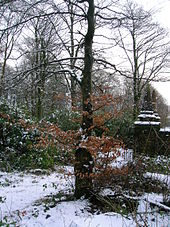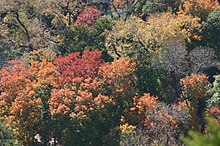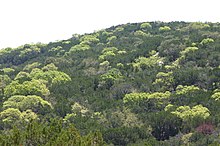Marcescence is the retention of dead plant organs that normally are shed. It is most obvious in deciduous trees that retain leaves through the winter. Several trees normally have marcescent leaves such as oak (Quercus), beech (Fagus) and hornbeam (Carpinus), or marcescent stipules as in some but not all species of willows (Salix). Marcescent leaves of pin oak (Quercus palustris) complete development of their abscissior layer in the spring. The base of the petiole remains alive over the winter. Many other trees may have marcescent leaves in seasons where an early freeze kills the leaves before the abscission layer develops or completes development. Diseases or pests can also kill leaves before they can develop an abscission layer.


Oak with marcescent foliage.
Marcescent leaves may be retained indefinitely and do not break off until mechanical forces (wind for instance) cause the dry and brittle petioles to snap.
Many palms form a skirt-like or shuttlecock-like crown of marcescent leaves under new growth that may persist for years before being shed. In some species only juveniles retain dead leaves and marcescence in palms is considered a primitive trait.
Typical partial marcescence on a mature beech (Fagus sylvatica) tree.
The term marcescent is also used in mycology to describe a mushroom which (unlike most species, described as "putrescent") can dry out, but later revive and continue to disperse spores. Genus Marasmius is well known for this feature, which was considered taxonomically important by Elias Magnus Fries in his 1838 classification of the fungi.
Benefits
One possible advantage of marcescent leaves is that they may deter feeding of large herbivores, such as deer and moose, which normally eat the twigs and their nutritious buds. Dead, dry leaves make the twigs less nutritious and less palatable.
Marcescent leaves may protect some species from water stress or temperature stress. For example, in tropical alpine environments a wide variety of plants in different plant families and different parts of the world have evolved a growth form known as the caulescent rosette, characterized by evergreen rosettes growing above marcescent leaves. Examples of plants for which the marcescent leaves have been confirmed to improve survival, help water balance, or protect the plant from cold injury are Espeletia schultzii and Espeletia timotensis, both from the Andes.
The litter-trapping marcescent leaf crown of Dypsis palms accumulate detritus to enhance their nutritient supply. By the same token, palms with marcescent leaf bases are also more susceptible to epiphytic parasites like figs that may completely engulf and strangle the palms.
References- ^ Berkley, Earl E. 1931. Marcescent leaves of certain species of Quercus. Botanical Gazette 92: 85-93.
- ^ George W. Argus. "88. Salix planifolia Pursh". Flora of North America 7.
- ^ Hoshaw, R.W. and Guard, A.T. 1949. "Abscission of marcescent leaves of Quercus palustris and Q. coccinea". Botanical Gazette 110: 587–593.
- ^ Addicott, Fredrick T. (1982). Abscission. University of California Press. p. 51. ISBN 978-0-520-04288-9.
- ^ L.B. Holm-Nielsen, ed. (1989). Tropical Forests: Botanical Dynamics, Speciation & Diversity. Academic Press. p. 161. ISBN 978-0-08-098445-2.
- ^ Dowe, John (2010). Australian Palms: Biogeography, Ecology and Systematics. Csiro Publishing. p. 160. ISBN 978-0-643-10185-2.
- ^ Dransfield, John; Uhl, Natalie W. (2008). Genera Palmarum: the evolution and classification of palms. Kew Pub. p. 294. ISBN 978-1-84246-182-2.
marcescent in immature [descriptive of several spp.]
- ^ Moore, Harold Emery; Uhl, Natalie W. (1982). Major Trends of Evolution in Palms. New York Botanical Garden. p. 69.
- ^ See introduction to Roy E. Halling "A revision of Collybia s.l. in the northeastern United States & adjacent Canada" Inst. of Syst. Botany, The New York Botanical Garden, Bronx, NY 10458-5126
- ^ E. M. Fries Epicrisis systematis mycologici (1838) Uppsala: Typographia Academica
- ^ Svendsen, Claus R. 2001. Effects of marcescent leaves on winter browsing by large herbivores in northern temperate deciduous forests. Alces 37(2): 475-482.
- ^ Goldstein, G. and Meinzer, F.1983. Influence of insulating dead leaves and low temperatures on water balance in an Andean giant rosette plant. Plant, Cell & Environment6: 649-656.
- ^ Smith, Alan P.1979. Function of dead leaves in Espeletia schultzii (Compositae), and Andean caulescent rosette species. Biotropica 11: 43-47.
- ^ Bramwell, David; Caujapé-Castells, Juli (2011-07-21). The Biology of Island Floras. Cambridge University Press. p. 189. ISBN 978-1-139-49780-0.
- ^ Kramer, Gregory T. (2011). "Palm Tree Susceptibility to Hemi-Epiphytic Parasitism by Ficus". (M.S. thesis). University of Florida.
Wikipedia












